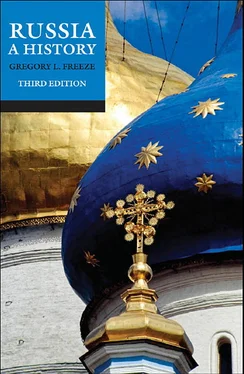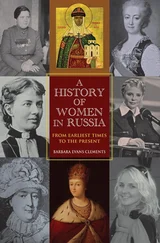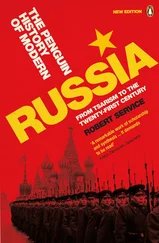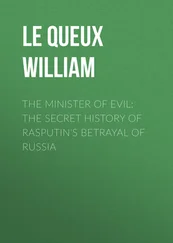By that time the realm of the Riurikid clan had expanded substantially. According to the Chronicle, the tribes subject to the Riurikids had increased to include the Krivichi (in the region of the Valdai hills), the Poliane (around Kiev on the Dnieper river), and the Drevliane (south of the Pripiat river, a tributary of the Dnieper). The Riurikids, furthermore, had taken command of the Dnieper, a major commercial artery. From the vantage-point of Kiev they could control all traffic moving down towards the Black Sea, the Byzantine colony of Kherson, and towards the sea route to the Don river and the Khazar Empire. Oleg in 907 and Igor, less successfully in 944, conducted military campaigns against Constantinople, which resulted in treaties permitting the Rus to trade not only at Kherson, but at the rich markets of Constantinople itself, where they mingled with merchants and had access to goods from virtually every corner of the known world.
Sviatoslav (962–72) continued to expand his forefathers’ domain. He first subdued the Viatichi, who inhabited lands along the Oka and Volga rivers and had previously paid tribute to the Khazars, and in 965 he launched a campaign against the Khazars themselves. His venture led to the collapse of their empire and, subsequently, the destabilization of the lower Volga and the steppe, a region of grasslands south of the Slav territories. Although he did rescue Kiev from the Pechenegs (a nomadic Turkic population that occupied the steppe) in 968, Sviatoslav devoted most of his attention to establishing control over lands on the Danube river. Forced to abandon that project by the Byzantines, he was returning to Kiev when he was killed by the Pechenegs in 972.
Shortly after Sviatoslav’s death his son Iaropolk became prince of Kiev, but conflict erupted between him and his brothers. After one died in battle against him, another brother, Vladimir, fled from Novgorod, the city that he governed, to raise an army in Scandinavia. Upon his return in 980, he first engaged the prince of Polotsk, one of the last non-Riurikid rulers of the East Slav tribes. Victorious, Vladimir married the prince’s daughter and added the prince’s military retinue to his own army, with which he then defeated Iaropolk and seized the throne of Kiev. Vladimir also subjugated the Radimichi (east of the upper Dnieper river), and in 985 attacked the Volga Bulgars; the agreement he subsequently reached with the latter was the basis for peaceful relations that lasted for a century. Vladimir’s triumphs over competing rulers and neighbouring powers established him as the sole ruler of the East Slav tribes and gave his heirs a monopoly over the right to succeed him. His family, which traced its lineage to Riurik, the progenitor of the dynasty, ruled the lands of Rus until 1598.
Over the next generations Vladimir and his successors continued to extend their domain and to create an apparatus to govern it. The political structure they devised for Kievan Rus was based on the concept that its lands were the possession of the dynasty. Thus, as his father had done, Vladimir assigned a portion of his realm to each of his principal sons. Thereafter, the Riurikid princes continued to share the lands of Kievan Rus and the responsibilities for administering and defending them.
Princely administration gradually replaced tribal allegiance and authority. As early as the reign of Olga, officials representing the Kievan ruler began to replace tribal leaders. Vladimir extended this practice by assigning particular lands to his sons, to whom he also delegated responsibility for tax-collection, for protection of communication and trade routes, and for local defence and territorial expansion. Each prince also had his own military force, which was supported by tax revenues, commercial fees, and booty seized in battle. After Vladimir’s son Grand Prince Iaroslav (d. 1054) issued a law code known as the Russkaia pravda, the Rus princes also became enforcers of Riurikid law. The administration of justice, which upheld both Riurikid authority and social order, yielded revenues in the form of court fees and fines. The Russkaia pravda, as amended by Iaroslav’s sons and later provisions that continued to be added to it until the thirteenth century, remained in force long after the Kievan era; it was not formally replaced until the law code (Sudebnik) of 1497 was adopted.
Over the two centuries following Vladimir’s death (1015), Kievan Rus became an amalgam of principalities, whose number increased as the dynasty itself grew. The main principalities in the centre of the realm were Kiev, Chernigov, and Pereiaslavl. Galicia and Volhynia (south-west of Kiev) gained the status of separate principalities in the late eleventh and twelfth centuries, respectively. During the twelfth century Smolensk (north of Kiev on the upper Dnieper) and Rostov-Suzdal (in the north-east) similarly emerged as powerful principalities. The north-western portion of the realm was dominated by Novgorod, whose strength rested on its lucrative commercial relations with Scandinavian and German merchants of the Baltic as well as on its own extensive empire that stretched to the Ural mountains by the end of the eleventh century. After 1097 each of these principalities (with the exceptions of Novgorod and Kiev) was identified with its own branch of the dynasty.
The Riurikid dynasty also converted Kievan Rus to Christianity and thereby provided it with a uniform religious and cultural framework. Christianity, Judaism, and Islam had long been known in these lands, and Olga had personally converted to Christianity. When Vladimir assumed the throne, however, he set idols of Norse, Slav, Finn, and Iranian gods, worshipped by the disparate elements of his society, on a hilltop in Kiev in an attempt to create a single pantheon for his people. But for reasons that remain unclear he soon abandoned this attempt in favour of Christianity. He thereupon gave up his numerous wives and consorts and married Anna, the sister of the Byzantine emperor Basil. The patriarch of Constantinople appointed a metropolitan to organize the see of Kiev and all Rus, and in 988 Byzantine clergy baptized the population of Kiev in the Dnieper river.
Christianity was not confined to Kiev. When Prince Vladimir dispatched his sons to their portions of his realm, each was accompanied by clergymen and charged with establishing and defending Christianity as well as the dynasty’s own authority. In some regions the introduction of the new religion and its clergy met overt resistance. When representatives of the new Church threw the idol of the god Perun into the Volkhov river in Novgorod, for example, their action provoked a popular uprising. Elsewhere resistance was passive; the populace simply continued to honour their traditional gods and practise their rituals in relatively private settings. Thus, although the lands of Rus formally entered the Christian world in 988, it was centuries before the population transferred their faith and loyalties to the Christian Church.
In the mean time, however, the Church, supported by the Riurikid princes, transformed the cultural face of Kievan Rus, especially in its urban centres. The change occurred first in Kiev, which was not only the seat of the senior Riurikid prince, but also the ecclesiastical centre of Kievan Rus. Vladimir removed the pagan idols he had previously erected and in their stead ordered the construction of Christian churches. The most notable was the Church of the Holy Virgin (also known as the Church of the Tithe), which was built in stone and flanked by two other palatial structures. The ensemble formed the centre-piece of ‘Vladimir’s city’, which was surrounded by new fortifications. A generation later Prince Iaroslav expanded this sector of the city by replacing the walls built by his father with new fortifications that encompassed the battlefield on which he defeated the Pechenegs in 1036. Inset into its southern wall was the Golden Gate of Kiev. Within the protected area he constructed a new complex of churches and palaces, the most imposing of which was the stone-built Cathedral of St Sophia—the church of the metropolitan and the symbolic centre of Christianity in Kievan Rus.
Читать дальше












